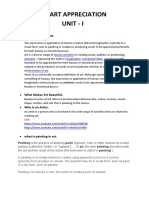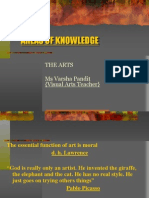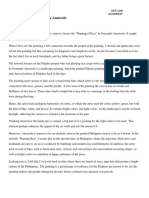0 ratings0% found this document useful (0 votes)
6 viewsArt
Art
Uploaded by
countryball80Copyright:
© All Rights Reserved
Available Formats
Download as DOCX, PDF, TXT or read online from Scribd
Art
Art
Uploaded by
countryball800 ratings0% found this document useful (0 votes)
6 views9 pagesCopyright
© © All Rights Reserved
Available Formats
DOCX, PDF, TXT or read online from Scribd
Share this document
Did you find this document useful?
Is this content inappropriate?
Copyright:
© All Rights Reserved
Available Formats
Download as DOCX, PDF, TXT or read online from Scribd
Download as docx, pdf, or txt
0 ratings0% found this document useful (0 votes)
6 views9 pagesArt
Art
Uploaded by
countryball80Copyright:
© All Rights Reserved
Available Formats
Download as DOCX, PDF, TXT or read online from Scribd
Download as docx, pdf, or txt
You are on page 1of 9
Art
It can be a painting in a museum or a
sculpture in a park. Or maybe a movie that
knocks your socks off. It can be a painted
Chinese screen, an African mask, a Persian
rug, or ancient Egyptian jewelry. Or a
photo that captures a moment in history. It
might be a construction made out of
automobile parts. It’s all art.
WHAT IS ART?
We call lots of things art today. We use the
term visual arts to describe the arts we can
see. Painting, sculpture, and architecture
have long been the major visual arts in
Europe and North America. Today, we
include photography, furniture, pottery,
jewelry, and many other arts and crafts
among the visual arts.
Sometimes we speak of the fine arts—
other forms of expression that appeal to our
sense of beauty and form. This broader
category includes literature, music, and
dance, in addition to the visual arts.
PAINTING, SCULPTURE, AND
ARCHITECTURE
Painting, sculpture, and architecture have
all been around for a long time. We tend to
consider them the most important forms of
art.
People painted and drew on the walls of
caves during the Stone Age, as long as
32,000 years ago. They made pictures of
animals—probably the animals they
hunted for food.
Over time, artists started painting different
subjects. They painted landscapes, portraits
of people, religious figures, and still lifes
(fruit, flowers, and other objects that don’t
move).
Sculpture is as old as painting. The first
sculptures we know about are small human
figures. The human figure remained the
most popular subject of sculpture until the
20th century. Today, sculptors are
concerned more with the materials of
sculpture than with subjects. They even
make sculptures out of junk and other
objects they find lying around.
Architecture is both an art and a science—
the art and science of making buildings.
Rulers and religions are responsible for
putting up some of the most impressive
buildings in the world. Rulers built
magnificent palaces to display their wealth
and power. Religions need churches,
mosques, temples, and other structures as
places of worship. Religious buildings also
celebrate the mysteries of religion.
WHY DO WE MAKE ART?
Everybody likes to draw, swoosh paint
around with their fingers or a brush, or
model things out of clay. The desire to
make art is universal. People make art
everywhere, and they seem to have been
doing it for as long as they’ve been around.
One of the main reasons for making art is
pleasure. We enjoy making art and we
enjoy looking at it. We find beauty in art,
and that gives us pleasure. We also admire
the skill and imagination that go into
making art.
Art has served other purposes, too. Think
about portraits—pictures of people. Before
there were cameras, a portrait was how
people remembered someone who wasn’t
there.
Portraits of rulers made them look
powerful to impress their subjects. History
paintings reminded people of victories in
battle and other important events.
Sculptures also commemorated rulers and
victories.
Before many people could read, art
instructed and educated. For example,
stained glass windows in churches were
meant to teach people stories in the Bible.
Many paintings from the past show
religious scenes.
NEW IDEAS ABOUT ART
Our ideas about art changed during the
1900s. Technology expanded our notions
of art. Photographs and film are new kinds
of art that developed from new inventions.
Today, people also create art on computers.
Artists also changed our ideas about art. In
1913, French artist Marcel Duchamp put a
bicycle wheel on display in an art gallery.
Nobody considered it art at the time. But
Duchamp claimed it was art because he
said so.
What did Duchamp mean? He meant that
he had changed how we look at the bicycle
wheel by putting it in a gallery. We could
now see the wheel as a beautiful object, not
just as a bicycle part. He turned other
everyday objects into art to make people
look at things differently.
Some artists decided to get rid of subject
matter. They focused instead on shapes,
lines, colors, and other elements of art.
These artists made what we call abstract
art. You can’t see objects in abstract art.
But you can respond to colors and shapes.
Perhaps they make you feel happy or sad.
Art museums also broadened our ideas of
art. They began to display the arts that add
beauty to our homes and our bodies. These
so-called decorative arts include furniture,
pottery, glass, fashion, and jewelry.
AT THE ART MUSEUM
Don’t try to take in too much when you
visit a museum. You’ll just get tired. Find
something you like to look at. Make
comparisons.
Perhaps you like a particular color.
Compare paintings to see how different
artists have used that color. Look for that
color in other kinds of art—for example, in
rugs and pottery. What other colors do
artists put with your color? Does your color
get brighter or dimmer as a result?
Maybe you like art with animals. Pick an
animal and find it in different paintings,
carvings, weavings, or pots. Has the artist
made you see things about the animal
you’ve never noticed before?
Microsoft ® Encarta ® 2009. © 1993-2008
Microsoft Corporation. All rights reserved.
You might also like
- Gateways To Art 4th Edition PDFDocument25 pagesGateways To Art 4th Edition PDFjejoteg540No ratings yet
- The Different Forms of ArtDocument5 pagesThe Different Forms of ArtJohn last50% (2)
- Museum Ludwig Cologne 20th Century PhotographyDocument764 pagesMuseum Ludwig Cologne 20th Century PhotographyКиевская Школа Фотографии100% (1)
- The Complete Prints of Francis Bacon CatDocument396 pagesThe Complete Prints of Francis Bacon CatHemaNihed100% (1)
- Cpar Lesson 1Document78 pagesCpar Lesson 1Rhea DiaperaNo ratings yet
- The Do-It-Yourself Guide to Creating Beautiful SculpturesFrom EverandThe Do-It-Yourself Guide to Creating Beautiful SculpturesRating: 1 out of 5 stars1/5 (1)
- Cpar Lesson 1Document8 pagesCpar Lesson 1Rhea DiaperaNo ratings yet
- Art Appreciation Unit 1Document13 pagesArt Appreciation Unit 1IswaryaNo ratings yet
- Arts ReviewerDocument7 pagesArts ReviewerKrishelle Kate PannigNo ratings yet
- Fine ArtsDocument12 pagesFine Artsatul prajapatiNo ratings yet
- Uh A Me Ed Fine Arts PresentationDocument161 pagesUh A Me Ed Fine Arts PresentationHoàng LinhNo ratings yet
- CHAPTER 8 ArtsDocument4 pagesCHAPTER 8 ArtsArthur John BaloNo ratings yet
- CPAR PPT Q3 Week 1Document24 pagesCPAR PPT Q3 Week 1Erly De GuzmanNo ratings yet
- UNIT 1 Integrative Art As Applied To Contemporary ArtDocument15 pagesUNIT 1 Integrative Art As Applied To Contemporary ArtMaria RodelynNo ratings yet
- UNIT 1 Integrative Art As Applied To Contemporary ArtDocument14 pagesUNIT 1 Integrative Art As Applied To Contemporary ArtMaria RodelynNo ratings yet
- Art and The ArtsDocument5 pagesArt and The ArtsdtqcNo ratings yet
- Art Appreciation Notes UNIT - 1Document13 pagesArt Appreciation Notes UNIT - 1francy sharonNo ratings yet
- An Introduction To ArtDocument16 pagesAn Introduction To ArtTimothyNo ratings yet
- ART Vocab.Document1 pageART Vocab.Gurjinder SinghNo ratings yet
- Art and Culture AssignmentDocument4 pagesArt and Culture AssignmentkanwaljeetNo ratings yet
- Different Art FormsDocument60 pagesDifferent Art FormsLerre Feigh GasparNo ratings yet
- Lesson 4 Categories and Presentation of Art: Module: Arts and HumanitiesDocument6 pagesLesson 4 Categories and Presentation of Art: Module: Arts and HumanitiesJhona Baguna TrabajadaNo ratings yet
- ArtDocument2 pagesArtSunray Jan GriñoNo ratings yet
- Subjective and Objective Perspectives Intended Learning OutcomesDocument9 pagesSubjective and Objective Perspectives Intended Learning OutcomesShai GuiamlaNo ratings yet
- Chapter 3Document9 pagesChapter 3keanalbertfelicianoNo ratings yet
- Differentiating Art History From Art AppreciationDocument35 pagesDifferentiating Art History From Art AppreciationHadji VillaflorNo ratings yet
- Semi0final PeriodsofartDocument151 pagesSemi0final Periodsofartallyssabanaag6No ratings yet
- 09-Suman Navalakha Art &designDocument32 pages09-Suman Navalakha Art &designSneha PeriwalNo ratings yet
- UntitledDocument6 pagesUntitledBianca Mae CabreraNo ratings yet
- Art Subject For Elementary Visual Arts XLDocument26 pagesArt Subject For Elementary Visual Arts XLGlen joseph SerranoNo ratings yet
- Gehumms Module 1 and 2 SummaryDocument7 pagesGehumms Module 1 and 2 SummaryDo KyungsooNo ratings yet
- Introduction & DefinationsDocument48 pagesIntroduction & DefinationsSuhairaNo ratings yet
- Week 5 The Western Art History 1Document38 pagesWeek 5 The Western Art History 1porealyneNo ratings yet
- Arts Appreciation Concept Notes 1 10Document13 pagesArts Appreciation Concept Notes 1 10jeschlyn lambinoNo ratings yet
- Art Appreciation-Second SemDocument47 pagesArt Appreciation-Second SemJessa Mae Cac100% (1)
- Module 2 GNED 01 Art HistoryDocument11 pagesModule 2 GNED 01 Art HistoryABCEDE, ANDREANo ratings yet
- Art 9Document4 pagesArt 9Noyaaa 侘寂No ratings yet
- Areas of Knowledge The ArtsDocument24 pagesAreas of Knowledge The ArtsAshita Naik100% (1)
- Cpar ReviewerDocument9 pagesCpar ReviewerDeniseJade LeguardaNo ratings yet
- Definition of ArtDocument14 pagesDefinition of ArtDeep ChowdhuryNo ratings yet
- Art in Asia InfosDocument5 pagesArt in Asia InfosAngeline BalbuenaNo ratings yet
- HUMN5 LecturesDocument12 pagesHUMN5 LecturesRonalyn GarciaNo ratings yet
- Cpar Unit Test 1Document24 pagesCpar Unit Test 1JACOB SANTOSNo ratings yet
- Lesson-1 Contemp Arts 12Document45 pagesLesson-1 Contemp Arts 12John Hector KiskisNo ratings yet
- Art HistoryDocument7 pagesArt HistoryJHEA BELLE GONZALESNo ratings yet
- L 11Document5 pagesL 11basadrejaneoNo ratings yet
- Humanities 1Document26 pagesHumanities 1Elmer TaripeNo ratings yet
- Art Therapy Lec.1Document26 pagesArt Therapy Lec.1emmapaps05No ratings yet
- Art Appreciation (Art Throughout The History) PDFDocument25 pagesArt Appreciation (Art Throughout The History) PDFAileen ValenzuelaNo ratings yet
- What Is ArtDocument4 pagesWhat Is ArtKyle De LeonNo ratings yet
- Characteristics of Contemporary Art 1Document7 pagesCharacteristics of Contemporary Art 1Hienz AndrwNo ratings yet
- What Are The Different Art FormsDocument15 pagesWhat Are The Different Art FormsHannah Grepo100% (1)
- The Arts Nature and Meaning of Arts: Fig. 1 Cave PaintingsDocument15 pagesThe Arts Nature and Meaning of Arts: Fig. 1 Cave PaintingsTrishaNo ratings yet
- Different Forms of ArtDocument3 pagesDifferent Forms of ArtMicol Detera PanganibanNo ratings yet
- LESSON+1 WHAT+IS+ART Handouts 1Document4 pagesLESSON+1 WHAT+IS+ART Handouts 1AudreyMaeNo ratings yet
- Matutulog Na Ko BwhahahhahaDocument10 pagesMatutulog Na Ko Bwhahahhahadermha LuigiNo ratings yet
- Art Is UniversalDocument10 pagesArt Is Universalbrent belarminoNo ratings yet
- How Are Arts ClassifiedDocument3 pagesHow Are Arts ClassifiedVirgilio BiagtanNo ratings yet
- Prelim Lesson in Art AppreciationDocument10 pagesPrelim Lesson in Art AppreciationBES BEBENo ratings yet
- Art 002 ReviewerDocument8 pagesArt 002 ReviewerKent JuguilonNo ratings yet
- Report - Imperio - History of Art AppreciationDocument14 pagesReport - Imperio - History of Art AppreciationJason del RosarioNo ratings yet
- Art Ap - Module 1Document19 pagesArt Ap - Module 1Rizza valenciaNo ratings yet
- Digestive SystemDocument3 pagesDigestive Systemcountryball80No ratings yet
- Bones and SkeletonDocument3 pagesBones and Skeletoncountryball80No ratings yet
- 2022 RaceDocument49 pages2022 Racecountryball80No ratings yet
- The Nervous SystemDocument11 pagesThe Nervous Systemcountryball80No ratings yet
- IctDocument3 pagesIctcountryball80No ratings yet
- Untitled DocumentDocument2 pagesUntitled Documentcountryball80No ratings yet
- English ReviewerDocument3 pagesEnglish Reviewercountryball80No ratings yet
- HELE ReviewerDocument3 pagesHELE Reviewercountryball80No ratings yet
- Science ReviewerDocument3 pagesScience Reviewercountryball80No ratings yet
- Visual Elements in The Philippine Traditional Motifs and CraftsDocument65 pagesVisual Elements in The Philippine Traditional Motifs and CraftsJiulla Queennie Torralba100% (2)
- Vincent Van GoghDocument3 pagesVincent Van Goghla rat suiiNo ratings yet
- 12th Deccani Miniature PaintingDocument25 pages12th Deccani Miniature Paintingsandy BoiNo ratings yet
- Handouts of Paithani and KanjeevaramDocument10 pagesHandouts of Paithani and KanjeevaramSiddhi PisalNo ratings yet
- Standeees GraphicsDocument14 pagesStandeees Graphicssri krithikaNo ratings yet
- Visual Arts Analysis (Planting Rice - Fernando Amorsolo)Document2 pagesVisual Arts Analysis (Planting Rice - Fernando Amorsolo)Diane Cruz33% (3)
- MAX Brand Manual AW 15092020Document61 pagesMAX Brand Manual AW 15092020Garima JagtaniNo ratings yet
- MAC - Acervo, Outras Abordagens - Vol. XVIDocument227 pagesMAC - Acervo, Outras Abordagens - Vol. XVIDaniel SiqueiraNo ratings yet
- Project ExampleDocument182 pagesProject ExampleKirubel AyeleNo ratings yet
- Art Grade 6 Notes Term 1Document11 pagesArt Grade 6 Notes Term 1Denis WaweruNo ratings yet
- Media Based Arts and Technology in The PhilippinesDocument28 pagesMedia Based Arts and Technology in The PhilippinesHoneyNo ratings yet
- Leseprobe 9783791379630Document39 pagesLeseprobe 9783791379630ahmedhamdi731No ratings yet
- Module 4 Art Processes and TechnquesDocument26 pagesModule 4 Art Processes and TechnquesAllysa Marie SilbolNo ratings yet
- PKS Bu TantiDocument39 pagesPKS Bu TantiDikyasa SurakartaNo ratings yet
- StegosaurusDocument6 pagesStegosaurusAlicia HetfieldNo ratings yet
- Lista de Productos HP Con Codigo EAN y Numero de ParteDocument18 pagesLista de Productos HP Con Codigo EAN y Numero de Parteing_oscarNo ratings yet
- Pink Project PresentationDocument12 pagesPink Project PresentationNisrina Piscesta AmalieNo ratings yet
- Review of The Light Down by H SatishDocument1 pageReview of The Light Down by H SatishBalakrishna DoraNo ratings yet
- Cardboard SculpturesDocument17 pagesCardboard Sculpturesapi-711870471No ratings yet
- Directions: Answer Directly To The Given: How Will You Promote Arts From A Particular Region? Make Sure To Cite ExamplesDocument31 pagesDirections: Answer Directly To The Given: How Will You Promote Arts From A Particular Region? Make Sure To Cite ExamplesRaiza CabreraNo ratings yet
- Production Resume 2 24Document1 pageProduction Resume 2 24api-641519665No ratings yet
- Doctor Blade Selection (Daetwyler Swiss)Document13 pagesDoctor Blade Selection (Daetwyler Swiss)kam ka weiNo ratings yet
- Farbcode Alphabetisch Farbcode: (2K Vorl./2K Lasur)Document2 pagesFarbcode Alphabetisch Farbcode: (2K Vorl./2K Lasur)Fabio KruseNo ratings yet
- ArtsDocument18 pagesArtsSophia DionisioNo ratings yet
- Honeycomb Knit DressDocument5 pagesHoneycomb Knit DressDaria DNo ratings yet
- Post ModernismDocument21 pagesPost ModernismShreepriya BirajdarNo ratings yet
- B7 Cad Tsol 1Document6 pagesB7 Cad Tsol 1elikplimkzanuNo ratings yet
- Eumind Onstage Architecture ScriptDocument7 pagesEumind Onstage Architecture ScriptHetviNo ratings yet


































































































